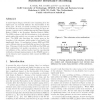Free Online Productivity Tools
i2Speak
i2Symbol
i2OCR
iTex2Img
iWeb2Print
iWeb2Shot
i2Type
iPdf2Split
iPdf2Merge
i2Bopomofo
i2Arabic
i2Style
i2Image
i2PDF
iLatex2Rtf
Sci2ools
108
Voted
ICCAD
2002
IEEE
2002
IEEE
Theoretical and practical validation of combined BEM/FEM substrate resistance modeling
In mixed-signal designs, substrate noise originating from the digital part can seriously influence the functionality of the analog part. As such, accurately modeling the properties of the substrate as a noise-propagator is becoming ever more important. A model can be obtained through the Finite Element Method (FEM) or the Boundary Element Method (BEM). The FEM performs a full 3D discretization of the substrate, which makes this method very accurate and flexible but also slow. The BEM only discretizes the contact areas on the boundary of the substrate, which makes it less flexible, but significantly faster. A combination between BEM and FEM can be efficient when we need flexibility and speed at the same time. This paper briefly describes the BEM and the FEM and their combination, but mainly concentrates on the theoretical validation of the combined method and the experimental verification through implementation in the SPACE layout to circuit extractor and comparison with commerc...
| Added | 17 Mar 2010 |
| Updated | 17 Mar 2010 |
| Type | Conference |
| Year | 2002 |
| Where | ICCAD |
| Authors | Eelco Schrik, Patrick Dewilde, N. P. van der Meijs |
Comments (0)

